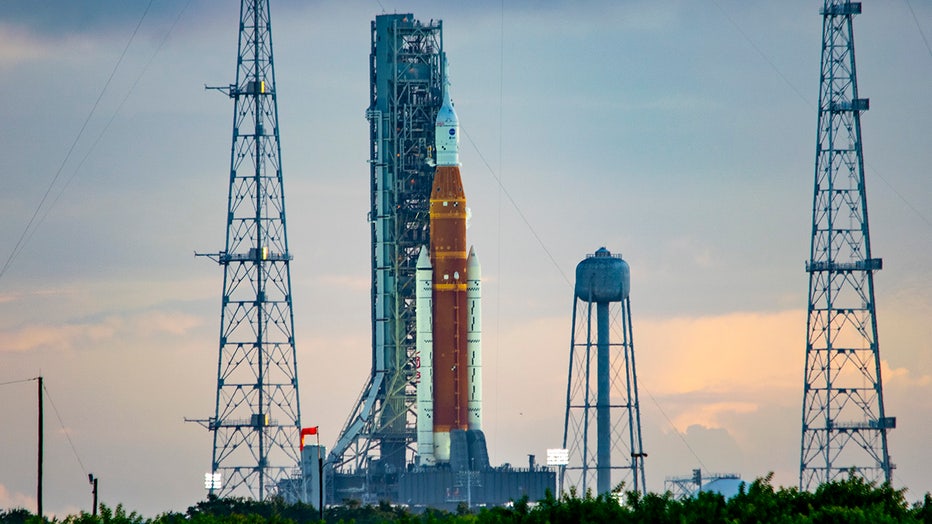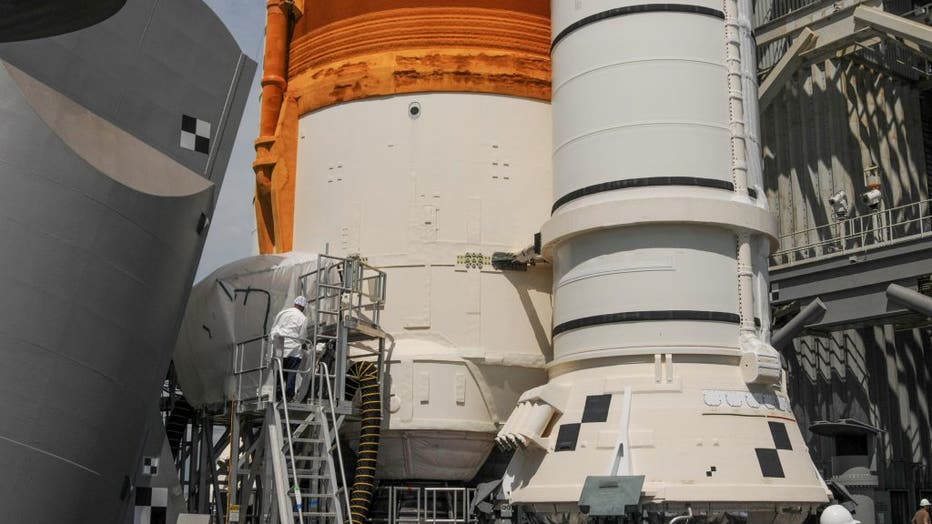NASA to roll back Artemis I rocket to prepare for Hurricane Ian; next launch attempt in November
NASA’s Space Launch System (SLS) rocket with the Orion spacecraft aboard is seen atop the mobile launcher at Launch Pad 39B, Monday, Aug. 29, 2022, as the Artemis I launch teams load more than 700,000 gallons of cryogenic propellants including liquid
CAPE CANAVERAL, Fla. - NASA's mega moon rocket will have to wait to launch until mid-November as engineers are preparing to roll back the Space Launch System rocket in preparation for Hurricane Ian.
On Saturday morning, NASA teams decided to stand down on preparing for a Tuesday launch opportunity to allow them time to configure systems for rolling back the SLS rocket and Orion spacecraft to the Vehicle Assembly Building.
Artemis I managers announced Monday plans to roll back the SLS to the VAB due to the latest Hurricane Ian forecast, which includes Florida's Space Coast in the cone of uncertainty.
The first motion of the crawler used to move the giant rocket is expected to happen at 11 p.m. ET Monday.
Until the 4-mile journey back to the hangar, the moon rocket remains vertical at Kennedy Space Center Launch Pad 39B on Florida's east coast.

NASA's SLS rocket during fueling for its first launch attempt, Monday, August 29. (FOX photo)
NASA engineers deferred a final decision on rollback until Monday "after additional data gathered overnight did not show improving expected conditions for the Kennedy Space Center area," the space agency said in a blog post.
"The decision allows time for employees to address the needs of their families and protect the integrated rocket and spacecraft system. The time of first motion also is based on the best-predicted conditions for rollback to meet weather criteria for the move," NASA said.
To make an informed decision, NASA considered the latest data from the National Oceanic and Atmospheric Administration, U.S. Space Force and the National Hurricane Center.
NASA associate administrator of science Dr. Thomas Zurbuchen said the space agency has been prioritizing the people working on the mission who may be impacted by Hurricane Ian as well as the mission.
"What we've been trying to do over the last few days is really balance those (priorities) and learn more as the hurricane is approaching us," Zurbuchen told FOX Weather. "The threat at this moment in time has been considered high enough based on all these inputs that it's just the right thing to roll back, which means that we bring it back and … in the mid to late November timeframe is really the next time we can roll back out and take another shot on goal."

After disconnecting the ground and rocket-side plates on the interface, called a quick disconnect, for the liquid hydrogen fuel feed line, teams have replaced the seals on the core stage of the Space Launch System associated with the liquid hydrogen
Overcoming technical hurdles
When the SLS launch does happen, this will be the third launch attempt for NASA's moon rocket.
After two previous scrubs due to unruly hydrogen leaks and an engine cooling issue, NASA fueled the SLS with more than 700,000 gallons of cryogenic propellant during a test last week to determine if engineers had resolved the problems.
Overall, NASA management called the test a success.
ARTEMIS-1 MOON ROCKET FUELING TEST COMPLETE AFTER NASA ENGINEERS OVERCOME HYDROGEN LEAK
"There's not an objective that we had that day that we did not achieve," NASA SLS chief engineer John Blevins said.
The latest launch window was not entirely up to the space agency. NASA first needed approval from the Space Force, which oversees the Eastern Range, to extend the Flight Termination System certification due to safety requirements. The FTS is required on all rockets and would cause the vehicle to self-destruct if it veers off course and threatens the public.
On Friday, Blevins shared the good news that the Space Force approved both the Sept. 27 and Oct. 2 backup dates, but both dates will now pass without a countdown.
Engineers will replace the FTS batteries in the VAB ahead of the next launch attempt.
LINK: Get updates on this story from FOXweather.com

